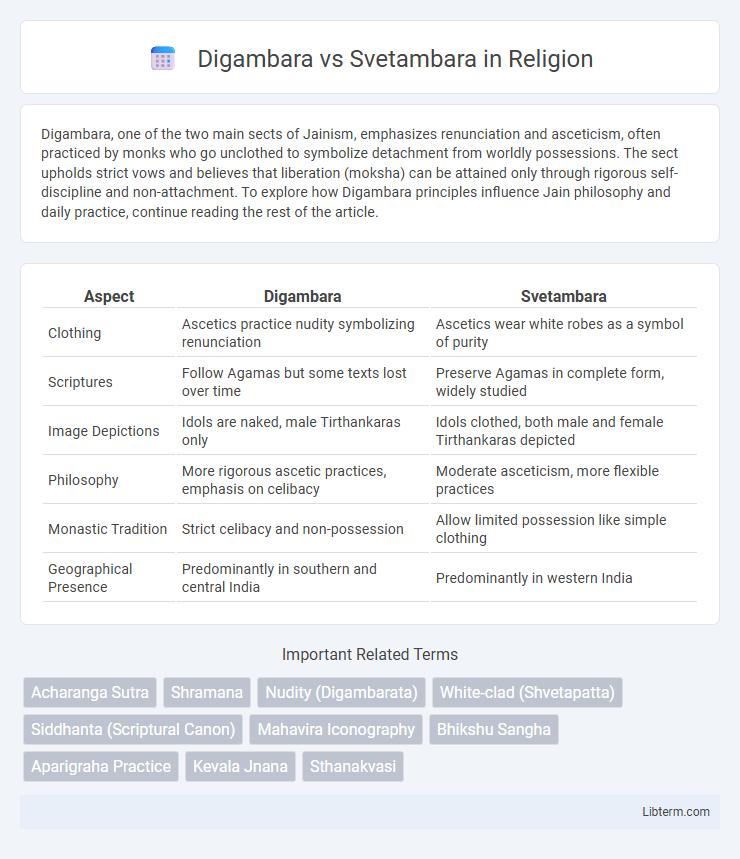Digambara, one of the two main sects of Jainism, emphasizes renunciation and asceticism, often practiced by monks who go unclothed to symbolize detachment from worldly possessions. The sect upholds strict vows and believes that liberation (moksha) can be attained only through rigorous self-discipline and non-attachment. To explore how Digambara principles influence Jain philosophy and daily practice, continue reading the rest of the article.
Table of Comparison
| Aspect | Digambara | Svetambara |
|---|---|---|
| Clothing | Ascetics practice nudity symbolizing renunciation | Ascetics wear white robes as a symbol of purity |
| Scriptures | Follow Agamas but some texts lost over time | Preserve Agamas in complete form, widely studied |
| Image Depictions | Idols are naked, male Tirthankaras only | Idols clothed, both male and female Tirthankaras depicted |
| Philosophy | More rigorous ascetic practices, emphasis on celibacy | Moderate asceticism, more flexible practices |
| Monastic Tradition | Strict celibacy and non-possession | Allow limited possession like simple clothing |
| Geographical Presence | Predominantly in southern and central India | Predominantly in western India |
Origins of Digambara and Svetambara Sects
The Digambara and Svetambara sects of Jainism originated from a split that occurred around the 3rd century BCE, primarily due to differences in ascetic practices and scriptures following a prolonged famine. Digambara monks adopted strict nudity symbolizing renunciation, while Svetambara monks wore white robes, reflecting differing interpretations of conduct and austerity. These divisions also influenced the development of distinct religious texts and rituals, carving out unique identities within Jainism's spiritual traditions.
Core Philosophical Differences
Digambara and Svetambara sects of Jainism differ fundamentally in their approach to ascetic practices and interpretations of liberation. Digambaras emphasize complete nudity as a symbol of renunciation and believe that only males can achieve moksha, while Svetambaras allow white-clad ascetics and accept that women can attain liberation. These differences reflect deeper philosophical disputes regarding purity, gender, and the path to spiritual liberation within Jain doctrine.
Distinctive Monastic Practices
Digambara monks practice nudity, symbolizing complete renunciation, while Svetambara monks wear simple white robes, reflecting modesty and detachment. Digambara ascetics carry a peacock feather broom and avoid any form of possessions, whereas Svetambara monks use a mouth cover to prevent harming microorganisms. These divergent monastic practices highlight contrasting interpretations of austerity and non-attachment within Jainism.
Scriptural and Textual Variations
Digambara and Svetambara sects of Jainism differ significantly in their scriptural and textual traditions, with Digambaras recognizing a set of ancient Agamas lost to time, relying instead on secondary texts like the Shatkhandagama and Kasayapahuda. Svetambaras preserve and revere a larger canon of 45 Agamas believed to be direct teachings of Mahavira, written in Ardhamagadhi Prakrit. These textual variations influence doctrinal interpretations, ritual practices, and the overall theological framework unique to each sect.
Symbolism and Religious Attire
Digambara monks symbolize renunciation through their practice of nudity, representing complete detachment from worldly possessions, while Svetambara monks wear simple white robes symbolizing purity and non-attachment. The Digambara attire emphasizes asceticism and the rejection of materialism, with the absence of clothing highlighting spiritual liberation. In contrast, the white robes of Svetambara monks serve as a visible emblem of cleanliness and disciplined living within the Jain monastic community.
Views on Women and Asceticism
Digambara Jains believe women cannot achieve liberation without first being reborn as men, emphasizing strict asceticism including complete nudity for monks, symbolizing non-attachment. Svetambara Jains accept women as capable of attaining liberation and allow ascetics to wear simple white clothes, reflecting a less austere practice. These divergent views highlight fundamental doctrinal differences regarding gender roles and ascetic discipline within Jainism.
Temple Architecture and Iconography
Digambara temple architecture is characterized by austere, monolithic structures with minimal ornamentation, reflecting their emphasis on asceticism, while Svetambara temples often feature ornate carvings and vibrant paintings that depict their scriptures and rituals. Iconographically, Digambara statues portray Tirthankaras as nude, symbolizing renunciation, typically with unadorned, serene expressions and elongated earlobes. Svetambara icons differ with Tirthankaras clothed in white robes and adorned with simple jewelry, emphasizing accessibility and spiritual purity.
Rituals, Festivals, and Worship
Digambara Jains observe rituals with strict ascetic practices, including the renunciation of all possessions and wearing no clothes, emphasizing the practice of non-possession and meditation; their festivals focus on Vardhamana Mahavira's life events with intense fasting and pilgrimage activities. Svetambara Jains, on the other hand, perform rituals involving the wearing of white clothes, elaborate temple worship, and scriptural recitations, celebrating festivals like Paryushana and Diwali with communal prayers and charitable acts. Both sects uphold the significance of rituals, festivals, and worship as expressions of devotion and spiritual purification, but they differ markedly in iconography, ascetic discipline, and ceremonial customs.
Historical Evolution and Spread
Digambara and Svetambara sects of Jainism diverged around the 3rd century BCE, with Digambaras adopting rigorous ascetic practices and rejecting the use of clothing, symbolizing complete renunciation. The Digambara tradition primarily spread in southern and central India, while the Svetambara sect, which allowed the wearing of white robes, flourished mainly in western and northern India. Historical texts and archaeological findings, such as inscriptions and ancient manuscripts, highlight distinct rituals, monastic codes, and philosophical interpretations that shaped the geographical and cultural distribution of both sects over centuries.
Contemporary Influence and Global Presence
Digambara and Svetambara sects of Jainism exhibit distinct contemporary influences shaped by demographics and cultural practices; Digambara followers predominantly reside in southern and central India, emphasizing ascetic ideals, while Svetambara adherents are more widespread across western and northern India, practicing more liberal rituals. Globally, Svetambara Jain communities have established a stronger presence due to migration patterns, creating vibrant diasporic centers in countries like the United States, the United Kingdom, and East Africa, fostering Jain cultural and religious education. Digambara institutions maintain influence through monasteries and pilgrimage sites in India, promoting traditional scholarship and ascetic practices that continue to attract international scholars and devotees.
Digambara Infographic

 libterm.com
libterm.com